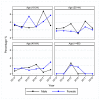Trends in Primary Mental Health Care Service Use and Subsequent Self-Harm in Western Sydney Australia: Policy and Workforce Implications
- PMID: 35329072
- PMCID: PMC8951314
- DOI: 10.3390/ijerph19063382
Trends in Primary Mental Health Care Service Use and Subsequent Self-Harm in Western Sydney Australia: Policy and Workforce Implications
Abstract
Background: This study investigated the trends in primary mental health care (PMHC) service use and hospital-treated self-harm in Western Sydney (Australia). Methods: A data linkage study and descriptive ecological study of PMHC referrals investigated the trends in referrals, treatment attendance, hospital-treated self-harm, and health care practitioners (HCPs) for the period of 2013−2018 (n = 19,437). Results: There was a substantial increase in referrals from 2016. The majority of referrals were females (60.9%), those aged <45 years (71.3%), and those presenting with anxiety or affective disorders (78.9%). Referrals of those at risk of suicide increased from 9.7% in 2013 to 17.8% in 2018. There were 264 (2.2%) cases of subsequent hospital-treated self-harm, with higher rates among those at risk of suicide and those who attended <6 sessions. The number of HCPs per referral also increased from 2013, as did waiting times for treatment initiation. Conclusion: Individuals presenting to PMHC services at risk of suicide, and who subsequently presented to a hospital setting following self-harm, were more likely to either not attend services following a referral or to attend fewer services. This trend occurred in the context of an increase in the number of clients per HCP, suggesting workforce capacity has not kept pace with demand.
Keywords: mental health policy; primary mental health care; psychological treatments; self-injurious behavior.
Conflict of interest statement
The authors declare no conflict of interest.
Figures






Similar articles
-
Determinants of treatment non-attendance among those referred to primary mental health care services in Western Sydney, Australia: a retrospective cohort study.BMJ Open. 2020 Oct 26;10(10):e039858. doi: 10.1136/bmjopen-2020-039858. BMJ Open. 2020. PMID: 33109673 Free PMC article.
-
Determinants of treatment disengagement among those at risk of suicide referred to primary mental health care services in Western Sydney, Australia.Aust N Z J Psychiatry. 2021 Mar;55(3):277-288. doi: 10.1177/0004867420963738. Epub 2020 Oct 9. Aust N Z J Psychiatry. 2021. PMID: 33032444
-
Referral patterns to primary mental health services in Western Sydney (Australia): an analysis of routinely collected data (2005-2018).Int J Ment Health Syst. 2020 May 26;14:37. doi: 10.1186/s13033-020-00368-5. eCollection 2020. Int J Ment Health Syst. 2020. PMID: 32508982 Free PMC article.
-
Self harm and attempted suicide in adults: 10 practical questions and answers for emergency department staff.Emerg Med J. 2006 Apr;23(4):251-5. doi: 10.1136/emj.2005.027250. Emerg Med J. 2006. PMID: 16549567 Free PMC article. Review.
-
Perceptions of paramedics and emergency staff about the care they provide to people who self-harm: Constructivist metasynthesis of the qualitative literature.J Psychosom Res. 2015 Jun;78(6):529-35. doi: 10.1016/j.jpsychores.2015.03.007. Epub 2015 Mar 16. J Psychosom Res. 2015. PMID: 25819635 Review.
Cited by
-
Identifying Solutions for the Workforce Challenges Facing Community Mental Health Support Workers: A Qualitative Study.Community Ment Health J. 2025 Oct;61(7):1324-1333. doi: 10.1007/s10597-025-01473-w. Epub 2025 May 22. Community Ment Health J. 2025. PMID: 40402441 Free PMC article.
-
Use of Data Linkage Methods to Investigate Healthcare Interactions in Individuals Who Self-harm and Die by Suicide: A Scoping Review.J Prev Med Public Health. 2025 Mar;58(2):114-126. doi: 10.3961/jpmph.24.448. Epub 2024 Nov 20. J Prev Med Public Health. 2025. PMID: 39638294 Free PMC article.
References
-
- Hickie I., Groom G. Primary care-led mental health service reform: An outline of the Better Outcomes in Mental Health Care initiative. Australas. Psychiatry. 2002;10:376–382. doi: 10.1046/j.1440-1665.2002.00498.x. - DOI
-
- Littlefield L., Giese J. The genesis, implementation and impact of the Better Access mental health initiative introducing Medicare-funded psychology services. Clin. Psychol. 2008;12:42–49. doi: 10.1080/13284200802192084. - DOI
-
- National Mental Health Commission . The National Review of Mental Health Programmes and Services. Volume 67 NMHC; Sydney, Australia: 2014.
-
- Australian Government Department of Health. NATIONAL PHN GUIDANCE Initial Assessment and Referral for Mental Healthcare—Version 1.05. [(accessed on 30 November 2021)];2020 Available online: https://www.health.gov.au/sites/default/files/documents/2021/09/primary-....
MeSH terms
LinkOut - more resources
Full Text Sources
Medical
Miscellaneous

